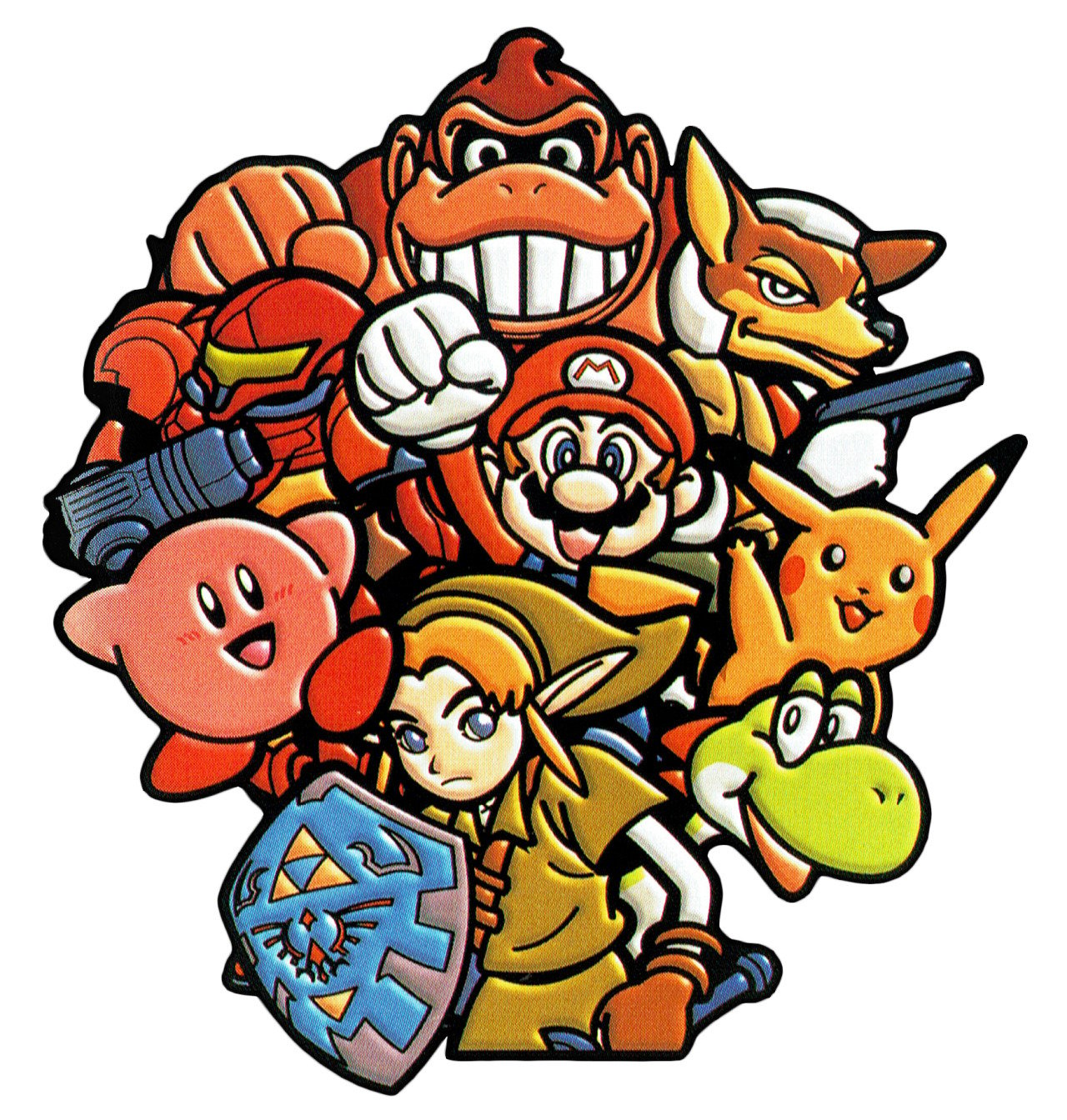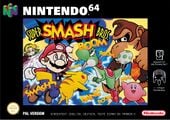Super Smash Bros.: Difference between revisions
(→Trivia: I demand a source before I let this statement back in.) |
No edit summary |
||
| Line 1: | Line 1: | ||
:''For the article about the series, | :''For the article about the series, see [[Super Smash Bros. (series)]].'' | ||
{{Infobox Game | {{Infobox Game | ||
|title = {{FA-article}}Super Smash Bros. | |title = {{FA-article}}Super Smash Bros. | ||
| Line 47: | Line 47: | ||
[[Image:Ssb_stageselect.jpg|thumb|200px|The stages of ''Super Smash Bros.'']] | [[Image:Ssb_stageselect.jpg|thumb|200px|The stages of ''Super Smash Bros.'']] | ||
*[[Peach's Castle]] | *[[Peach's Castle]] | ||
*[[ | *[[Congo Jungle]]* | ||
*[[Hyrule Castle]] | *[[Hyrule Castle]] | ||
*[[Planet Zebes]] | *[[Planet Zebes]] | ||
*[[Yoshi's Island | *[[Yoshi's Island (SSB)|Yoshi's Island]]* | ||
*[[Dream Land]]* | *[[Dream Land]]* | ||
*[[Sector Z]] | *[[Sector Z]] | ||
| Line 66: | Line 66: | ||
*[[Battlefield (SSB)|Battlefield]] | *[[Battlefield (SSB)|Battlefield]] | ||
*[[Final Destination (SSB)|Final Destination]] | *[[Final Destination (SSB)|Final Destination]] | ||
*[[ | *[[Meta Crystal]] | ||
===Non-playable stages=== | ===Non-playable stages=== | ||
| Line 110: | Line 110: | ||
<gallery widths="170"> | <gallery widths="170"> | ||
Image:Box ssb j.jpg|''Super Smash Bros.'' Japanese box art | Image:Box ssb j.jpg|''Super Smash Bros.'' Japanese box art | ||
Box ssb pal.jpg|''Super Smash Bros.'' PAL box art | File:Box ssb pal.jpg|''Super Smash Bros.'' PAL box art | ||
</gallery> | </gallery> | ||
</center> | </center> | ||
Revision as of 20:02, October 30, 2010
- For the article about the series, see Super Smash Bros. (series).
| Template:FA-articleSuper Smash Bros. | |
|---|---|
| Super Smash Bros. North American box | |
| Developer(s) | HAL Laboratory, Inc. |
| Publisher(s) | Nintendo |
| Designer(s) | Masahiro Sakurai |
| Released | Nintendo 64: Template:Europe November 19, 1999 Virtual Console: Template:Europe June 12th, 2009 |
| Mode(s) | Single-player, multiplayer (2-4) |
| Ratings | ESRB: E PEGI: 7 OFLC: G8+ |
| Platform(s) | Nintendo 64 iQue Player Virtual Console |
| Media | 128 megabit cartridge Flash Card (China) |
Super Smash Bros., known in Japan as Nintendo All-Star! Great Fray Smash Brothers (ニンテンドウオールスター! 大乱闘スマッシュブラザーズ, Nintendō Ōrusutā! Dairantō Sumasshu Burazāzu), and often shortened to "SSB" or "SSB64", is the game that started the Super Smash Bros. game series. It is the predecessor of Super Smash Bros. Melee, and the pre-predecessor to Super Smash Bros. Brawl.
It was released in Japan on January 21, 1999, in North America on April 26, 1999, and in Europe on November 19, 1999. It's playable on Nintendo 64 and the iQue Player and is available on the Wii's Virtual Console. The PAL Virtual Console version was released on June 12th 2009, and the American Virtual Console version was released on December 21, 2009.
Intro
<youtube>CMlwNVqdhNc</youtube>
Characters
There are twelve characters in Super Smash Bros., eight of which are available from the start, and four of which are unlockable.
Starter Characters
Secret characters
Non-Playable Characters
Stages
- Peach's Castle
- Congo Jungle*
- Hyrule Castle
- Planet Zebes
- Yoshi's Island*
- Dream Land*
- Sector Z
- Saffron City
* These stages reappear in Melee as Past Stages.
Unlockable Stage
Adventure stages
Non-playable stages
Modes
1-Player
Multi-player
Tournament play
Unlike Melee, Super Smash Bros. never enjoyed a large professional competitive scene, but interest in Super Smash Bros. has been renewed in recent years with the popularity of Melee and Brawl. Players can play Super Smash Bros. online through Kaillera using the Project64k emulator. However, there have been more and more tournaments of Super Smash Bros. recently due to an influx of new players. Most Smash 64 tournaments are paired up with Melee or long events and most (offline) Smash 64 tournaments are located in California, Central Canada, or New Jersey.
Standard tournament rules differ little from that of Melee. The most common standard tournament rules are as follows:
- Generally best 2 out of 3 (using 3 out of 5 or sometimes 4 out of 7 for finals)
- Double Elimination
- 5 stock
- 10 minute time limit, if it is possible, most emulators don't have time limit
- Items are turned off
- Handicaps are off
- The first match is selected randomly excluding Yoshi's Island, Sector Z, Planet Zebes, and Mushroom Kingdom.
- Mushroom Kingdom, Sector Z, and Yoshi's Island are usually banned: Mushroom Kingdom for pipe spamming/edge camping, Yoshi's Island for cloud camping and projectile camping, and Sector Z for the size and the Arwing lasers. Planet Zebes is sometimes banned as well, for the acid.
- The loser of each match picks the stage for the next match excluding the illegal stages listed above.
- If Saffron City is selected on the first round and one of the players is using Ness, he or she may request a re-pick.
- However, if the Ness player wins the match, his/her opponent may counterpick Saffron City.
- The loser cannot choose a stage on which a previous match was played (known as "Dave's stupid rule"). Due to the low number of allowed stages in this game, this is often weakened to the loser cannot choose the stage on which the last match was played.
- For the first match, characters are chosen double-blind - at the same time, so that neither player knows their opponent's character beforehand.
- Players may re-pick characters after each match. However, the loser of each match gets to pick last (known as slob picks).
Online Play
Although Super Smash Bros. does not feature online play, emulators have the ability to do so. Project64k and Mupen64k are the most used emulators of playing online.
Gallery
Commercials
<youtube>K783SDTBKmg</youtube> <youtube>ZYqXBP3IQ-Y</youtube>
Trivia
- Also, it was revealed in an interview with Nintendo's president, Satoru Iwata, that Masahiro Sakurai had intended for Final Smashes to be included in the original Super Smash Bros. He claims that he has proof in the form of recorded voices for when characters used their Final Smash. The idea, however, was never actually implemented until Brawl.
- The original Smash Bros. was originally going to be a game called "Dragon King: The Fighting Game" for the SNES which used the Super FX chip, and didn't have any Nintendo characters at all. There was going to be a new game series called Dragon King, which Dragon King the Fighting Game was going to be first in the series.[1]
- The starting eight characters are placed in the order of when they first appeared in their respective titles on the character selection screen, starting with the oldest, Mario and Donkey Kong, and leading to the most recent, Pikachu.
- When a character is chosen, they perform a brief animation in their player's display box below the character-select array. This is the only game in the series to have this feature.
- In the credits, Charles Martinet, the voice of Mario and Luigi, was misspelled as "Charles Martinee".
- In Melee and Brawl, the characters are trophies that have been brought to life, as demonstrated in their intro sequences and continue screens. This is not the case in Super Smash Bros., in which the characters are instead toys that have been brought to life by Master Hand, and the stages are dioramas.
- The Japanese Version lacks the "Congratulations" screen when you complete 1 player mode.
- The Japanese Version also has completely different sound effects for the hitting of the characters, which are much more realistic like those in Melee and Brawl and other arcade fighting games. This may possibly be a censorship done to keep the game more innocent/cartoony and make the E rating.
- The narrator also says "Fox" in a different tone than the Western version, and he says "Battle Royal" instead of "Free-for-all". In the Western versions, the re-recorded voices have a slightly different echo effect than the Japanese originals.
- In the European version of the game, when set to the German Language, the German announcer does not say "Captain Falcon" or "Team Battle" in German.
- Some items (excluding battering items and containers) and all Pokémon are actually 2D sprites.
- It's absolutely impossible (without hacking) to clear all the 8 digits on the counter that tells how many points the player has earned in 1P Mode.
- This is the only game in the series to receive a rating of E for everyone. Its sequels are both rated T for teen.
- This is the only game to exclusively feature Nintendo's heroes. Future installments included playable villains (i.e. Bowser).
- The playables are all veterans that return in Melee and Brawl.
External links
| Super Smash Bros. series | |
|---|---|
| Super Smash Bros. · Super Smash Bros. Melee · Super Smash Bros. Brawl · Super Smash Bros. 4 (for Nintendo 3DS · for Wii U) · Super Smash Bros. Ultimate |



